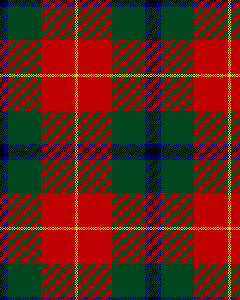

One of the valleys that run north out of the Cheviots into Teviotdale carries Rule water to its parent river. It is one of these pockets in which the most ancient stock of any country might survive, taking in the new blood of successive immigrants or conquerors, yet retaining an original identity. Bedrule lies in the recesses of hills that had once divided the Welsh-speaking kingdom of Gododdin from English Northumbria, and later formed the "debateable land" between Scotland and England. It is the original cradle of a tribe called the TURNBULLS. The earliest record of them appears in the time of the Anglo-Norman Kings of Scots. A Richard de Rullos is named there in 1130: a Gilbertus de Bebulle in 1248. The district itself is called Terra de Rul in 1266. But it seems unlikely that its inhabitants descend from one of the Anglo-Norman families whom the Scottish Kings brought from England or France. The name TURNBULL, and its legendary origin, suggest quite different affinities. Hector Boece related this legend as historical fact in 1526, in his account of the manner in which a man named Roull saved the life of King Robert Bruce in the forest of Callander, from a wild boar or bull. " after the beast felt himself sore wounded, he rushed upon the King who, having no weapon in his hand, had surely perished if help had not come. Howbeit, one came running unto him who overthrew the bull by plain force, and held him down until the hunters came who killed him outright. For this valiant act the King endowed the aforesaid party with great possessions, and his lineage to this day is called of the TURNBULL. "Had this been historical fact, it would provide supporting evidence that Robert I had planted a TURNBULL in Bedrule in the same way as he planted a Burnett at Banchory, for services rendered. But in addition to the negative evidence, there is the positive presence of a William "dicto TURNBULL" in records earlier than Bruce's reign . In any case, the heroic progenitor of the tribe who slays a dangerous wild beast belongs to the stock-in-trade of Celtic legend. The MacLeods have a version of it and the oldest one of all in Scotland was brought among the Ossianic tales from Ireland. In this one, Diarmaid, legendary progenitor of Clan Campbell, kills the wild boar in Gaelic ballad and folk tale. The principal difference between the MacLeod and Campbell versions on the one hand and the TURNBULL one on the other is that of language. The Welsh of the Gododdin epic - Scotland's earliest poem - had given way to English over a Thousand years before the poet of the TURNBULL country, John Leyden, wrote in 1801:






A counter claim to the legend that the name comes from the OLD ENGLISH "TRUMBALD" meaning strongly bold, is also feasible. There are many references to the TURNBULLS and RULES during the 1300's. John Leyden in his "Scenes of Infancy" describes the heroic deed. While the story is very much disputed by historians it is also very much recorded. The fact remains that Robert the Bruce did deed over certain lands for services rendered by RULE. William became something of a national hero and assumed a bull's head as his heraldic symbol with the motto, "I Saved The King". He met a gruesome end at the Battle of Halidon Hill in 1333. Bedrule Castle, built by the Conyns, was added to the possessions of Sir James Douglas, who installed a TURNBULL as its occupant. Bedrule Castle was destroyed by the English in 1545; the TURNBULLS continued in heritable possession until the end of the 18th century.
Descendants of the TURNBULLS of Bedrule include Bishop William TURNBULL, founder of Glasgow University in 1447, "Brother Johnathan" TRUMBULL, Governor of Connecticut and Dr. Andrew TURNBULL, founder of the ill fated colony of New Smyrna, Florida. Stephen TOURNEBULLE was procurator of the Scottish "nation" at the University of Orleans in 1507.
Throughout the ages, TURNBULLS have distinguished themselves as churchmen, scholars, scientists and administrators. TURNBULLS have been Provosts of Dunfermline and Edinburgh in Scotland. More recently a Commissioner of London Police; Myra TURNBULL, widow of our clan founder was the first Lady Provost of Hawick. The clan was dormant for hundreds of years until revived in 1977 by the late John TURNBULL of Hawick, Scotland.
The TURNBULL dress tartan was created by John TURNBULL using the main features of the Bruce and Douglas Tartans, both of these clans having had an integral part in the TURNBULL history.
The U.S. branch was founded and chartered in August, 1979 by Dorothy Turnbull Berk.


|
|